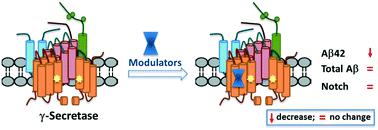当前位置:
X-MOL 学术
›
RSC Med. Chem.
›
论文详情
Our official English website, www.x-mol.net, welcomes your feedback! (Note: you will need to create a separate account there.)
Recent developments of small molecule γ-secretase modulators for Alzheimer's disease
RSC Medicinal Chemistry ( IF 4.1 ) Pub Date : 2020-08-27 , DOI: 10.1039/d0md00196a Shekar Mekala 1 , Grady Nelson 1 , Yue-Ming Li 1, 2
RSC Medicinal Chemistry ( IF 4.1 ) Pub Date : 2020-08-27 , DOI: 10.1039/d0md00196a Shekar Mekala 1 , Grady Nelson 1 , Yue-Ming Li 1, 2
Affiliation

|
Alzheimer's disease (AD) is the most common form of progressive neurodegenerative disorder, marked by memory loss and a decline in cognitive function. The major hallmarks of AD are the presence of intracellular neurofibrillary tau tangles (NFTs) composed of hyperphosphorylated tau proteins and extracellular plaques composed of amyloid beta peptides (Aβ). The amyloid (Aβ) cascade hypothesis proposes that the AD pathogenesis is initiated by the accumulation of Aβ peptides in the parenchyma of the brain. An aspartyl intramembranal protease called γ-secretase is responsible for the production of Aβ by the cleavage of the amyloid precursor protein (APP). Clinical studies of γ-secretase inhibitors (GSIs) for AD failed due to the lack of substrate specificity. Therefore, γ-secretase modulators (GSMs) have been developed as potential disease modifying agents to modulate the γ-secretase cleavage activity towards the production of toxic Aβ42 peptides. Following the first-generation ‘nonsteroidal anti-inflammatory drug’ (NSAID) based GSMs, second-generation GSMs (carboxylic acid based NSAID derivatives and non-NSAID derived heterocyclic analogues), as well as natural product-based GSMs, have been developed. In this review, we focus on the recent developments of small molecule-based GSMs that show potential improvements in terms of drug-like properties as well as their current status in human clinical trials and the future perspectives of GSM research.
中文翻译:

阿尔茨海默病小分子γ-分泌酶调节剂的最新进展
阿尔茨海默病 (AD) 是进行性神经退行性疾病的最常见形式,其特点是记忆力减退和认知功能下降。AD 的主要标志是存在由过度磷酸化的 tau 蛋白组成的细胞内神经原纤维 tau 缠结 (NFT) 和由淀粉样蛋白 β 肽 (Aβ) 组成的细胞外斑块。淀粉样蛋白 (Aβ) 级联假说提出 AD 发病机制是由 Aβ 肽在大脑实质中的积累引发的。一种称为 γ-分泌酶的天冬氨酰膜内蛋白酶负责通过切割淀粉样前体蛋白 (APP) 产生 Aβ。由于缺乏底物特异性,γ-分泌酶抑制剂 (GSI) 用于 AD 的临床研究失败。所以,γ-分泌酶调节剂 (GSM) 已被开发为潜在的疾病调节剂,以调节 γ-分泌酶裂解活性,以产生有毒的 Aβ42 肽。继第一代基于“非甾体抗炎药”(NSAID)的 GSM 之后,已经开发了第二代 GSM(基于羧酸的 NSAID 衍生物和非 NSAID 衍生的杂环类似物)以及基于天然产物的 GSM。在这篇综述中,我们重点关注基于小分子的 GSM 的最新进展,这些进展在类药物特性方面显示出潜在的改进,以及它们在人类临床试验中的现状以及 GSM 研究的未来前景。继第一代基于“非甾体抗炎药”(NSAID)的 GSM 之后,已经开发了第二代 GSM(基于羧酸的 NSAID 衍生物和非 NSAID 衍生的杂环类似物)以及基于天然产物的 GSM。在这篇综述中,我们重点关注基于小分子的 GSM 的最新进展,这些进展在类药物特性方面显示出潜在的改进,以及它们在人类临床试验中的现状以及 GSM 研究的未来前景。继第一代基于“非甾体抗炎药”(NSAID)的 GSM 之后,已经开发了第二代 GSM(基于羧酸的 NSAID 衍生物和非 NSAID 衍生的杂环类似物)以及基于天然产物的 GSM。在这篇综述中,我们重点关注基于小分子的 GSM 的最新进展,这些进展在类药物特性方面显示出潜在的改进,以及它们在人类临床试验中的现状以及 GSM 研究的未来前景。
更新日期:2020-09-23
中文翻译:

阿尔茨海默病小分子γ-分泌酶调节剂的最新进展
阿尔茨海默病 (AD) 是进行性神经退行性疾病的最常见形式,其特点是记忆力减退和认知功能下降。AD 的主要标志是存在由过度磷酸化的 tau 蛋白组成的细胞内神经原纤维 tau 缠结 (NFT) 和由淀粉样蛋白 β 肽 (Aβ) 组成的细胞外斑块。淀粉样蛋白 (Aβ) 级联假说提出 AD 发病机制是由 Aβ 肽在大脑实质中的积累引发的。一种称为 γ-分泌酶的天冬氨酰膜内蛋白酶负责通过切割淀粉样前体蛋白 (APP) 产生 Aβ。由于缺乏底物特异性,γ-分泌酶抑制剂 (GSI) 用于 AD 的临床研究失败。所以,γ-分泌酶调节剂 (GSM) 已被开发为潜在的疾病调节剂,以调节 γ-分泌酶裂解活性,以产生有毒的 Aβ42 肽。继第一代基于“非甾体抗炎药”(NSAID)的 GSM 之后,已经开发了第二代 GSM(基于羧酸的 NSAID 衍生物和非 NSAID 衍生的杂环类似物)以及基于天然产物的 GSM。在这篇综述中,我们重点关注基于小分子的 GSM 的最新进展,这些进展在类药物特性方面显示出潜在的改进,以及它们在人类临床试验中的现状以及 GSM 研究的未来前景。继第一代基于“非甾体抗炎药”(NSAID)的 GSM 之后,已经开发了第二代 GSM(基于羧酸的 NSAID 衍生物和非 NSAID 衍生的杂环类似物)以及基于天然产物的 GSM。在这篇综述中,我们重点关注基于小分子的 GSM 的最新进展,这些进展在类药物特性方面显示出潜在的改进,以及它们在人类临床试验中的现状以及 GSM 研究的未来前景。继第一代基于“非甾体抗炎药”(NSAID)的 GSM 之后,已经开发了第二代 GSM(基于羧酸的 NSAID 衍生物和非 NSAID 衍生的杂环类似物)以及基于天然产物的 GSM。在这篇综述中,我们重点关注基于小分子的 GSM 的最新进展,这些进展在类药物特性方面显示出潜在的改进,以及它们在人类临床试验中的现状以及 GSM 研究的未来前景。



























 京公网安备 11010802027423号
京公网安备 11010802027423号